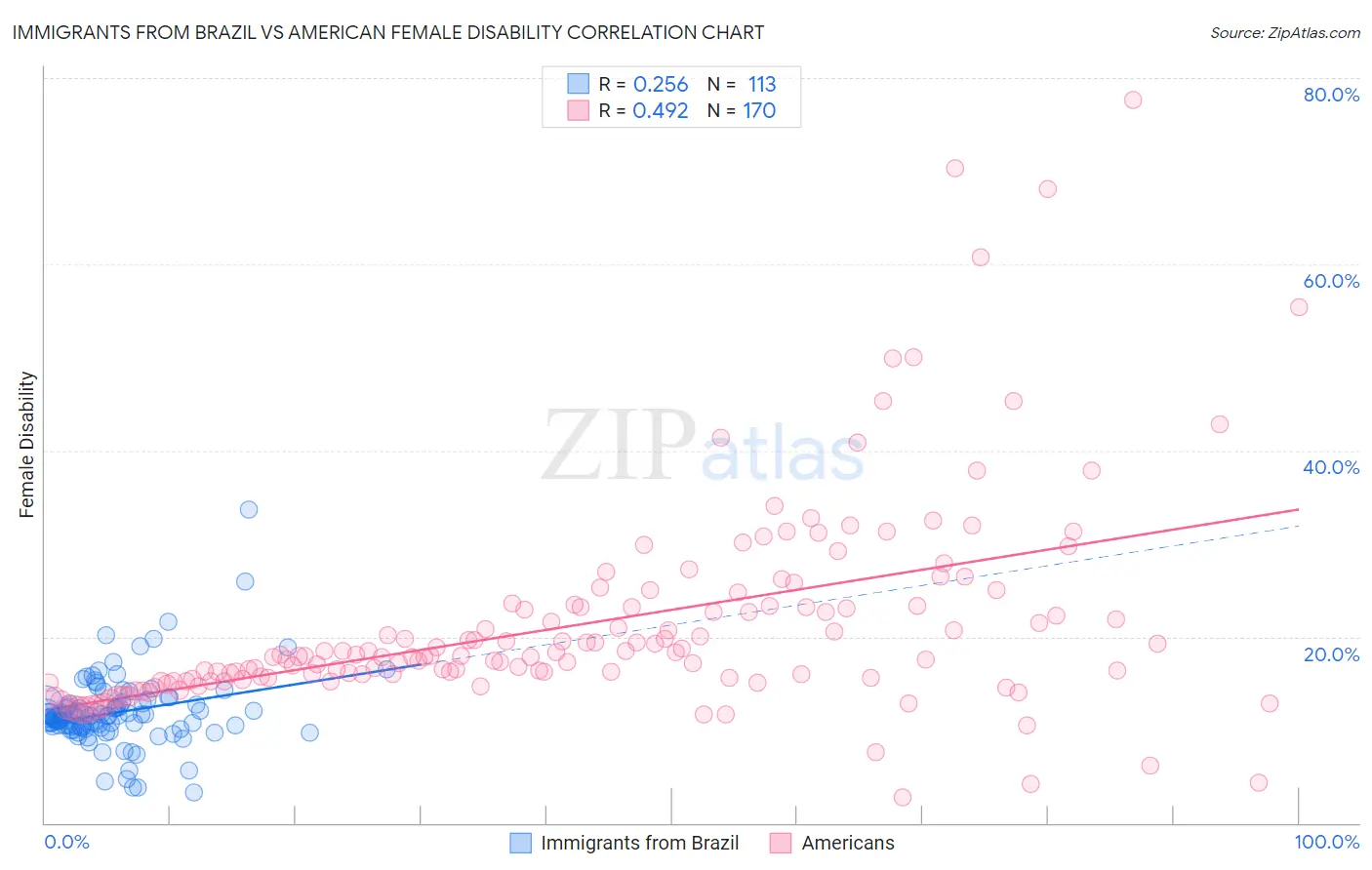Immigrants from Brazil vs American Female Disability
COMPARE
Immigrants from Brazil
American
Female Disability
Female Disability Comparison
Immigrants from Brazil
Americans
11.6%
FEMALE DISABILITY
99.4/ 100
METRIC RATING
94th/ 347
METRIC RANK
14.1%
FEMALE DISABILITY
0.0/ 100
METRIC RATING
320th/ 347
METRIC RANK
Immigrants from Brazil vs American Female Disability Correlation Chart
The statistical analysis conducted on geographies consisting of 343,005,923 people shows a weak positive correlation between the proportion of Immigrants from Brazil and percentage of females with a disability in the United States with a correlation coefficient (R) of 0.256 and weighted average of 11.6%. Similarly, the statistical analysis conducted on geographies consisting of 581,542,152 people shows a moderate positive correlation between the proportion of Americans and percentage of females with a disability in the United States with a correlation coefficient (R) of 0.492 and weighted average of 14.1%, a difference of 21.4%.

Female Disability Correlation Summary
| Measurement | Immigrants from Brazil | American |
| Minimum | 3.2% | 2.7% |
| Maximum | 33.7% | 77.6% |
| Range | 30.5% | 74.9% |
| Mean | 11.9% | 21.4% |
| Median | 11.5% | 17.9% |
| Interquartile 25% (IQ1) | 10.3% | 15.4% |
| Interquartile 75% (IQ3) | 12.8% | 23.3% |
| Interquartile Range (IQR) | 2.5% | 7.9% |
| Standard Deviation (Sample) | 4.0% | 11.3% |
| Standard Deviation (Population) | 4.0% | 11.2% |
Similar Demographics by Female Disability
Demographics Similar to Immigrants from Brazil by Female Disability
In terms of female disability, the demographic groups most similar to Immigrants from Brazil are Immigrants from Sierra Leone (11.6%, a difference of 0.030%), Immigrants from Northern Europe (11.6%, a difference of 0.070%), Immigrants from Zimbabwe (11.6%, a difference of 0.14%), Immigrants from Czechoslovakia (11.6%, a difference of 0.14%), and Immigrants from Romania (11.6%, a difference of 0.15%).
| Demographics | Rating | Rank | Female Disability |
| Immigrants | Denmark | 99.5 /100 | #87 | Exceptional 11.6% |
| Yup'ik | 99.5 /100 | #88 | Exceptional 11.6% |
| Vietnamese | 99.5 /100 | #89 | Exceptional 11.6% |
| Immigrants | Romania | 99.5 /100 | #90 | Exceptional 11.6% |
| Immigrants | Zimbabwe | 99.5 /100 | #91 | Exceptional 11.6% |
| Immigrants | Czechoslovakia | 99.5 /100 | #92 | Exceptional 11.6% |
| Immigrants | Sierra Leone | 99.4 /100 | #93 | Exceptional 11.6% |
| Immigrants | Brazil | 99.4 /100 | #94 | Exceptional 11.6% |
| Immigrants | Northern Europe | 99.4 /100 | #95 | Exceptional 11.6% |
| Immigrants | Russia | 99.0 /100 | #96 | Exceptional 11.7% |
| Koreans | 99.0 /100 | #97 | Exceptional 11.7% |
| Uruguayans | 98.8 /100 | #98 | Exceptional 11.7% |
| Immigrants | Philippines | 98.6 /100 | #99 | Exceptional 11.7% |
| Immigrants | Uruguay | 98.5 /100 | #100 | Exceptional 11.7% |
| Immigrants | Costa Rica | 98.4 /100 | #101 | Exceptional 11.7% |
Demographics Similar to Americans by Female Disability
In terms of female disability, the demographic groups most similar to Americans are Potawatomi (14.1%, a difference of 0.14%), Pueblo (14.1%, a difference of 0.15%), Black/African American (14.1%, a difference of 0.31%), Native/Alaskan (14.1%, a difference of 0.33%), and Iroquois (14.0%, a difference of 0.34%).
| Demographics | Rating | Rank | Female Disability |
| Blackfeet | 0.0 /100 | #313 | Tragic 13.8% |
| Puget Sound Salish | 0.0 /100 | #314 | Tragic 13.8% |
| Alaskan Athabascans | 0.0 /100 | #315 | Tragic 13.9% |
| Spanish Americans | 0.0 /100 | #316 | Tragic 14.0% |
| Chippewa | 0.0 /100 | #317 | Tragic 14.0% |
| Paiute | 0.0 /100 | #318 | Tragic 14.0% |
| Iroquois | 0.0 /100 | #319 | Tragic 14.0% |
| Americans | 0.0 /100 | #320 | Tragic 14.1% |
| Potawatomi | 0.0 /100 | #321 | Tragic 14.1% |
| Pueblo | 0.0 /100 | #322 | Tragic 14.1% |
| Blacks/African Americans | 0.0 /100 | #323 | Tragic 14.1% |
| Natives/Alaskans | 0.0 /100 | #324 | Tragic 14.1% |
| Navajo | 0.0 /100 | #325 | Tragic 14.2% |
| Comanche | 0.0 /100 | #326 | Tragic 14.2% |
| Ottawa | 0.0 /100 | #327 | Tragic 14.2% |